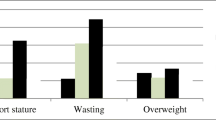Abstract
This cross-sectional study was undertaken to compare WHO and Indian Academy of Pediatrics (IAP) recommended growth charts compiled by Agarwal. 2105 children aged less than 5 years, attending 132 Anganwadi centres in Mysore city, were included by simple random sampling method. Weight and height of all children were recorded and plotted on both WHO and IAP charts. WHO charts detected more boys as underweight compared to IAP charts (P<0.0001). When weight charts of girls were compared there was no difference between the two charts. WHO charts detected more children with stunting than IAP charts, which was true for both boys and girls (P=0.001).
Similar content being viewed by others
References
WHO Multicentre Growth Reference Study Group. Enrolment and baseline characteristics in the WHO multicentre growth reference study. Acta Paediatr Suppl. 2006;450:7–15.
Wright C, Lakshman R, Emmett P, Ong KK. Implications of adopting the WHO 2006 child growth standard in the UK: two prospective cohort studies. Arch Dis Child. 2008;93:566–569.
de Onis M, Garza C, Onyango AW, Borghi E. Comparison of the WHO child growth standards and the CDC 2000 growth charts. J Nutr. 2007;137:144–148.
Van Dijk CE, Innis SM. Growth curve standards and the assessment of early excess weight gain in infancy. Pediatrics. 2009;123:102–108.
Khadilkar VV, Khadilkar AV, Choudhury P, Agarwal KN, Ugra D, Shah NK. IAP growth monitoring guidelines for children from birth to 18 years. Indian Pediatr. 2007;44:187–197.
Agarwal DK, Agarwal KN. Physical growth in Indian affluent children (birth-6yrs). Indian Pediatr. 1994;31:377–413.
Park K. Medicine and social sciencesIn: Park K editor. Park’s Textbook of Preventive and Social Medicine. 20th edition. Jabalpur: Banarsidas Bhanot Publishers; 2009. p.581–615.
Prinja S, Thakur JS, Bhatia SS. Pilot testing of WHO child growth standards in Chandigarh: implications for India’s child health programmes. Bull World Health Organ. 2009:87:116–122.
Deshmukh PR, Dongre AR, Gupta SS, Garg BS. Newly developed WHO growth standards: Implications for Demographic Surveys and Child Health Programs. Indian J Pediatr. 2007:74:987–990.
Khadilkar VV, Khadilkar AV, Chiplonkar SA. Growth performance of Affluent Indian Preschool Children: A comparison with the new WHO growth standard. Indian Pediatr. 2010:47:869–872.
Author information
Authors and Affiliations
Corresponding author
Rights and permissions
About this article
Cite this article
Savitha, M.R., Kondapuram, N. Comparison of 2006 WHO and Indian Academy of Pediatrics recommended growth charts of under five Indian children. Indian Pediatr 49, 737–739 (2012). https://doi.org/10.1007/s13312-012-0157-7
Received:
Revised:
Accepted:
Published:
Issue Date:
DOI: https://doi.org/10.1007/s13312-012-0157-7




